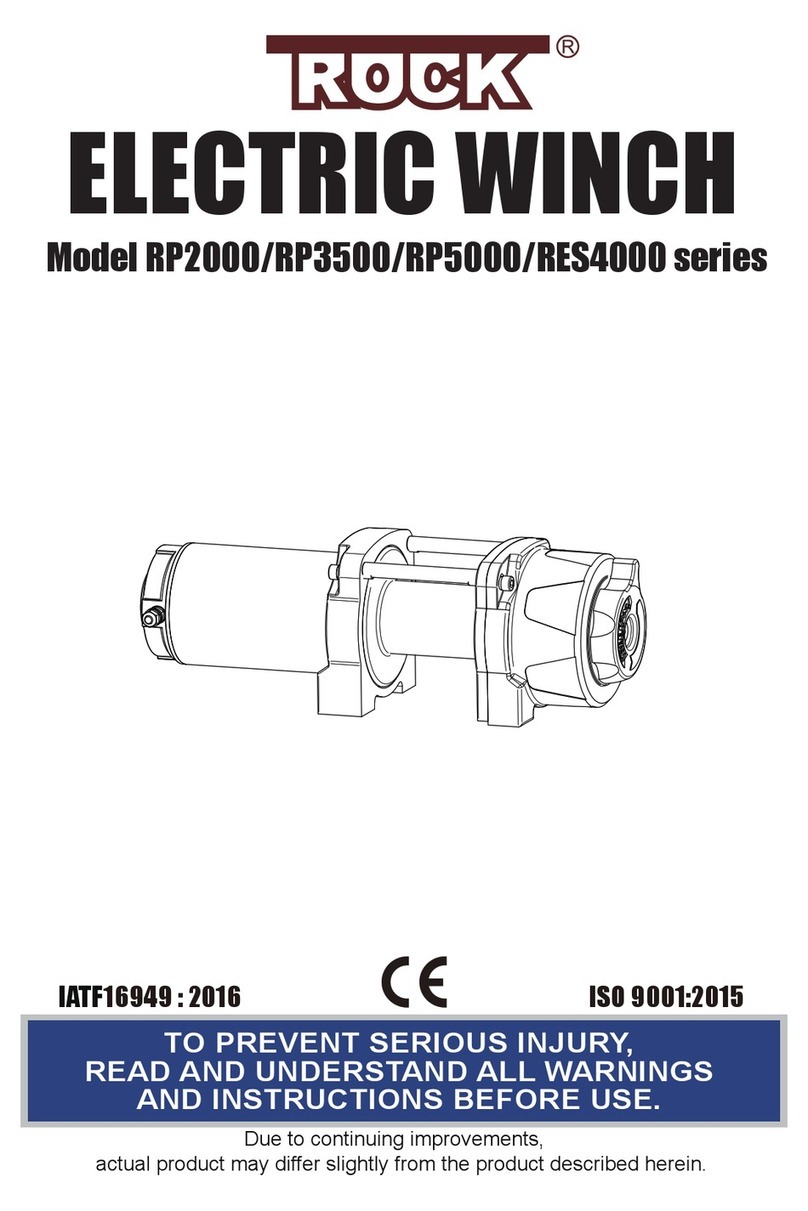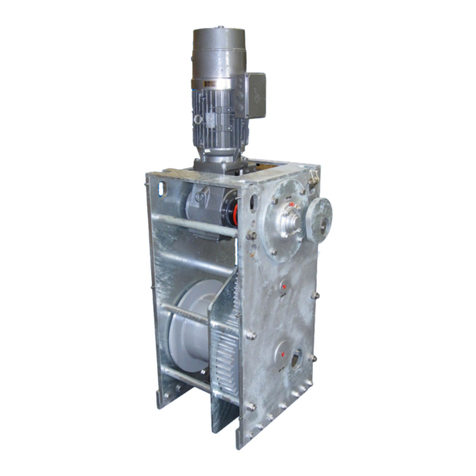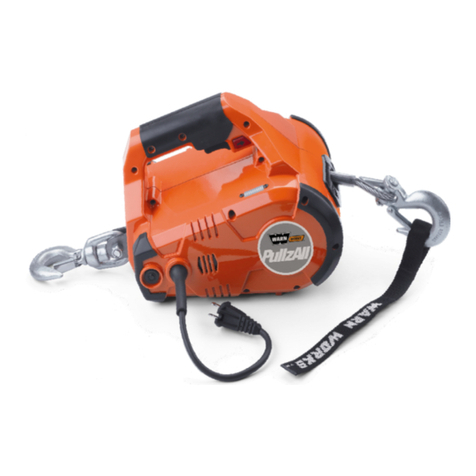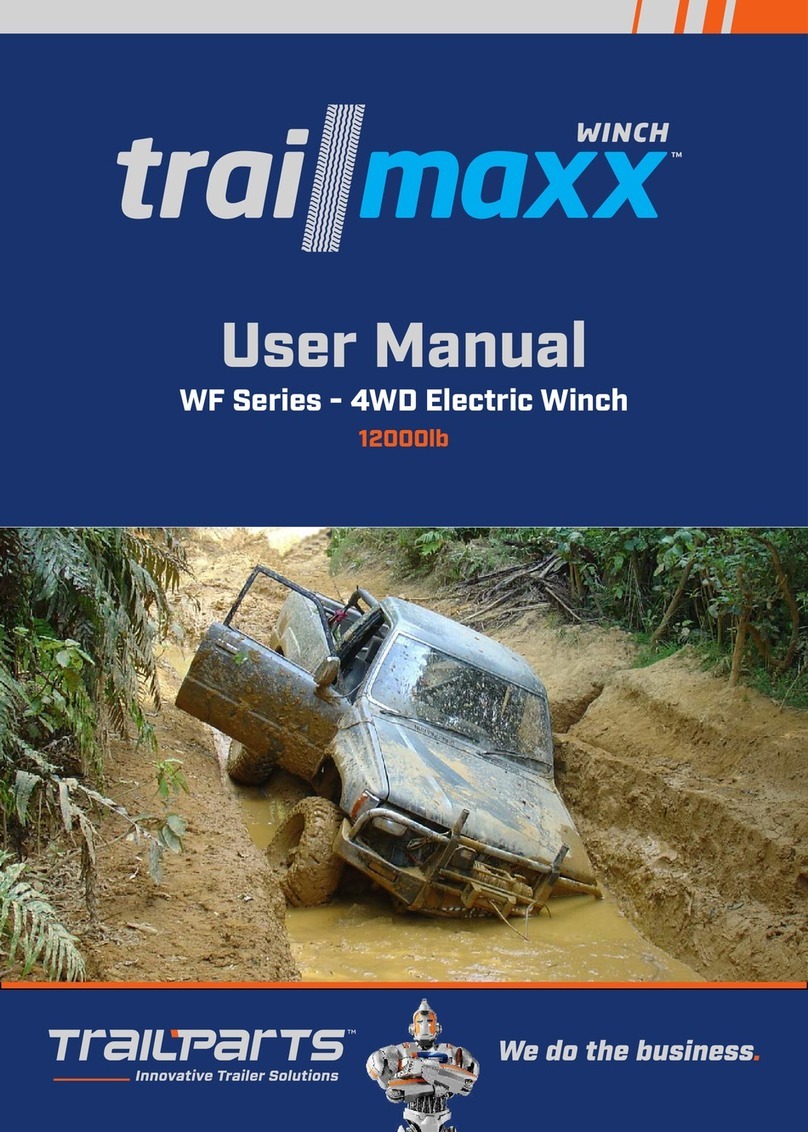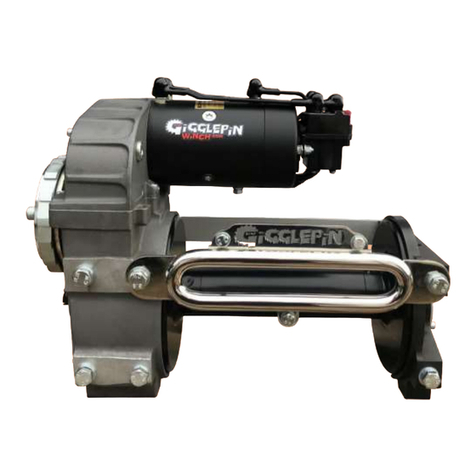Greifzug Tirak T 1000 series Specification sheet

tirak™
Electrically driven rope traction hoists for wire ropes for material transportation
Elektrisch angetriebene Seildurchlaufwinden für Drahtseile zur Materialbeförderung
Treuils électriques à défilement continu pour câbles métalliques pour le transport de matériaux
Elektrisch aangedreven kabeldoorlooplieren voor draadkabels voor het materiaaltransport
Model series / Typenreihe /
Série / Serie
T 1000
T 1020
Model series / Typenreihe /
Série / Serie
X 300
X 400
X 500
X 800
X 1020
X 1530
Model series / Typenreihe /
Série / Serie
X 3050
Original Operation and Installation Manual
Traduction du manuel d´installation et de
manutention original
Übersetzung der Original-Montage- und
Betriebsanleitung
Vertaling van de originele montage- en
bedieningshandleiding
English
Deutsch
Français
Nederlands

tirak™
EN-DE-FR-NL–II G932.1 - 06/2010
DE
FR
NL
ENEN
Technical Data / Technische Daten / Données techniques / Technische
gegevens
tirakTM
rope
Hoist
Load-carrying
capacity4)
Wire rope speed6)
Connection
Power
Nominal
current
Diameter
Minimum
breaking load5)
Weight
Dimensions / unit size
(see Fig. 2 and 3)
Temperature
range3)
Noise2)
tirakTM
Seil
Winde
Tragfähigkeit4)
Seilgeschwind-
igkeit6)
Anschluss
Leistung
Nennstrom
Durchmesser
Mindest-
bruchkraft5)
Gewicht
Abmessungen /
Einbaumaße
(siehe Abb. 2 und 3)
Temperatur-
bereich3)
Geräuschent-
wicklung2)
tirakTM
câble
Treuil
Capacité de
charge4)
Vitesse du câble6)
Branchement
Puissance
Courant
nominal
Diamètre
Effort de rupture
minimal5)
Poids
Dimensions /
Cotes de montage
(cf. Fig. 2 et 3)
Plage de tempé-
rature3)
Emission so-
nore2)
tirakTM
kabel
Lier
Draagvermogen4)
Kabelsnelheid6)
Aansluiting
Vermogen
Nominale
stroom
Diameter
Min.
breukkracht5)
Gewicht
Afmetingen/inbouwmaten
(zie Afb. 2 en 3)
Temperatuur-
bereik3)
Geluidsont-
wikkeling2)
a b c x/y
kg m/min
230 V
50 Hz
400 V
50 Hz
kW A
mm
kN
kg mm mm mm mm °C dB
(A)
X 300 9 – x 0,5 1,6 27 437 262 265
X 301 9 x – 0,45 4,5 29 476 257 245
X 300
X 302
300
18 – x 0,9 2,6
8
14,7
27 437 262 265
∼250 /
250
-10
…
+50
1)
72
X 400 9 – x 0,75 2,8 29 437
X 401 9 x – 0,75 6,5 32 452
X 402 18 – x 1,5 5 31 496
X 400
X 403
400
9/18 – x 0,75/1,5 2,8/5,1
8
19,6
35 452
273 285
∼250 / 250
-15
…
+70
72
X 500 9 – x 0,9 2,8 40 489 265
X 501 9 x – 0,9 6,5 49 556 256
X 502 18 – x 1,8 5 43 504 265
X 500
X 503
500
9/18 – x 0,9/1,8 2,8/5,1
8
24,5
47 504
297
285
∼250 / 250
-10
…
+50
1)
70
X 800 9 – x 1,6 4,5 45 525 297 265
X 803 9/18 – x 1,75/3,5 4/8 49 550 297 285
X 805 4,5/9 – x 0,8/1,6 3/4,2 50 563 304 285
X 800
X 806
800
9/18 – x 0,8/3,2 3,6/9
8
39,2
71 603 328 315
∼250 / 250
-10
…
+50
1) 70
T 1000 9 – x 1,9 4,6 71 580 336 311
T 1003 9/18 – x 1,9/3,8 5,5/9,5 85 642 355 348
T 1005 4,5/9 – x 0,9/1,9 3,6/4,6 84 642 355 318
T 1000
T 1006
980
4,5/18 – x 0,9/3,8 4/9,7
8
48,1
94 679 386 348
∼250 / 250
-10
…
+50
1) 70
T 1020 9 – x 1,9 4,6 71 580 336 311
T 1023 9/18 – x 1,9/3,8 5,5/9,5 85 642 355 348
T 1025 4,5/9 – x 0,9/1,9 3,6/4,6 84 642 355 318
T 1020
T 1026
980
4,5/18 – x 0,9/3,8 4/9,7
9
48,1
94 679 386 348
∼250 / 250
-10
…
+50
1) 70

tirak™
G932.1 - 06/2010 EN-DE-FR-NL–III
DE
FR
NL
ENEN
tirakTM
rope
Hoist
Load-carrying
capacity4)
Wire rope speed6)
Connection
Power
Nominal
current
Diameter
Minimum
breaking load5)
Weight
Dimensions / unit size
(see Fig. 2 and 3)
Temperature
range3)
Noise2)
tirakTM
Seil
Winde
Tragfähigkeit4)
Seilgeschwind-
igkeit6)
Anschluss
Leistung
Nennstrom
Durchmesser
Mindest-
bruchkraft5)
Gewicht
Abmessungen /
Einbaumaße
(siehe Abb. 2 und 3)
Temperatur-
bereich3)
Geräuschent-
wicklung2)
tirakTM
câble
Treuil
Capacité de
charge4)
Vitesse du câble6)
Branchement
Puissance
Courant
nominal
Diamètre
Effort de rupture
minimal5)
Poids
Dimensions /
Cotes de montage
(cf. Fig. 2 et 3)
Plage de tempé-
rature3)
Emission so-
nore2)
tirakTM
kabel
Lier
Draagvermogen4)
Kabelsnelheid6)
Aansluiting
Vermogen
Nominale stroom
Diameter
Min. breukkracht5)
Gewicht
Afmetingen/inbouwmaten
(zie Afb. 2 en 3)
Temperatuurbereik3)
Geluidsont-
wikkeling2)
Table/Tabelle/Tableau/Tabel 1
4) X-model series from 1000 kg load carrying capacity: with mechanical load limiting device; X-model series from
1000 kg load carrying capacity: mechanical or electric load limiting device can be supplied as an option. T
Model series: electric load limiting device can be supplied as an option.
X-Typenreihe ab 1000 kg Tragfähigkeit: mit mechanischer Hubkraftbegrenzung; X-Typenreihe bis 1000 kg
Tragfähigkeit: mechanische oder elektronische Hubkraftbegrenzung optional lieferbar. T-Typenreihen:
elektronische Hubkraftbegrenzung optional lieferbar.
Série X à partir d'une capacité de charge de 1000 kg : avec limitation mécanique de la force de levage; série X
jusqu'à une capacité de charge de 1000 kg : limitation mécanique ou électronique de la force de levage dispo-
nible en option. Séries T : limitation électronique de la force de levage disponible en option.
X-type serie vanaf 1000 kg draagvermogen: met mechanische hefkrachtbegrenzing; X-type serie tot 1000 kg
draagvermogen: mechanische of elektronische hefkrachtbegrenzing optioneel leverbaar. T-type series:
elektronische hefkrachtbegrenzing optioneel leverbaar.
1) expanded temperature range on request / erweiterter
Temperaturbereich auf Anfrage / extension de la plage de
température sur demande / uitgebreid temperatuurbereik op
aanvraag
2) at a distance of 1m / in 1 m Abstand / à 1m de distance / op 1 m
afstand
3) Depending on the ambient conditions (ambient temperature,
sunrays, etc.) as well as the possible thermal discharge (dirt, ac-
cumulated heat, etc.)
Abhängig von den Umgebungsbedingungen (Umgebungs-
temperatur, Sonneneinstrahlung, etc.) sowie der möglichen Wär-
meabfuhr (Schmutz, Stauwärme, etc.)
En fonction des conditions ambiantes (température ambiante,
rayonnement solaire etc.) et de l'éventuelle évacuation de la cha-
leur (saleté, accumulation de chaleur etc.)
Afhankelijk van de omgevingsvoorwaarden (omgevings-
temperatuur, zonbestraling, etc.) en van de mogelijke
warmteafleiding (vuil, warmteopstopping, etc.)
a b c x/y
kg m/min
230 V
50 Hz
400 V
50 Hz
kW A
mm
kN
kg mm mm mm mm °C dB
(A)
X 1020 9 – x 1,9 4,6 45 525 297 265
X 1023 9/18 – x 1,9/3,8 4,5/8,5 56 563 307 315
X 1025 4,5/9 – x 0,9/1,9 3,5/4,8 55 563 307 285
X 1020
X 1026
980
4,5/18 – x 0,9/3,8 4/9,6
9
48,1
71 605 332 315
∼250 / 250
-15
…
+70
70
X 1530
X 1530 1500 9 – x 2,8 7
10
73,6
49 522 297 285
∼250 / 250
-15
…
+70
70
X 3050 6 – x 3,8 9,9 105 669 400 372
X 3052 12 – x 7,5 17 117 681 403 372
X 3050
X 3053
3000
6/12 – x 3,8/7,5 9,9/19
14
147,2
156 786 428 442
∼250 / 250
-15
…
+70
78,5

tirak™
EN-DE-FR-NL–IV G932.1 - 06/2010
DE
FR
NL
ENEN
5) Calculation of the required minimum breaking load Foof the rope
(does not correspond to the actual, manufacturer-specific
minimum breaking load!):
Berechnung der erforderlichen Mindestbruchkraft Fodes Seiles
(entspricht nicht der tatsächlichen, herstellerspezifischen
Mindestbruchkraft!):
Calcul de l’effort de rupture mininal requis Fo du câble (ne
correspond pas à l’effort de rupture minimal effectif et spécifique
du fabricant!) :
Berekening van de minimum breukkracht Fo van de kabel (komt
niet overeen met de daadwerkelijke fabrikantspecifieke min.
breukkracht!):
Fo= Zpx S
Fo= 5 x S [kg] x 9,81 [N/mm²]
Fo: smallest guaranteed breaking load of the wire rope / kleinste garantierte
Bruchlast des Drahtseils / Charge de rupture minimale garantie du câble
métallique / kleinste gegarandeerde breuklast van de draadkabel
Zp: = 5: Expansion coefficient of the wire rope / Ausnutzungskoeffizient des
Drahtseils / Coefficient d’utilisation du câble métallique /
Belastingscoëfficiënt van de draadkabel
S: Maximum static load on the wire rope (load capacity of the hoist) / maximal
statische Zuglast im Drahtseil (Tragfähigkeit der Winde) / Charge statique
maximale du câble métallique (capacité de charge du treuil) / Maximale
statische treklast in draadkabel (draagvermogen van de lier)
6) In accordance with DIN 15020 the devices correspond to drive group 1 Bmat rope speeds of up to 9
m/min, and to drive group 1 Cmat a rope speed exceeding 9 m/min. The average operating time per
day with relation to a year (operating time class) depends on the actual load (load spectrum). /
Geräte entsprechen gemäß DIN 15020 bei Seilgeschwindigkeiten bis 9 m/min der Triebwerksgruppe
1 Bm, über 9 m/min Seilgeschwindigkeit der Triebwerksgruppe 1 Cm. Die mittlere Laufzeit je Tag
bezogen auf ein Jahr (Laufzeitklasse) ist abhängig von der tatsächlich auftretenden Belastung
(Lastkollektiv). /
Appareils conformément à DIN 15020 pour les vitesses de défilement du câble jusqu'à 9 m/min dans
la catégorie de mécanismes de treuil 1 Bm, vitesse de défilement du câble supérieure à 9 m/min dans
la catégorie de mécanismes de treuil 1 Cm. La durée de vie moyenne par jour rapportée à un an
(classe de durée de vie) est fonction de la charge réelle sur le câble (spectre de charge). /
Apparaten voldoen volgens DIN 15020 bij kabelsnelheden tot 9 m/min aan de eisen van de
drijfwerkgroep 1 Bm, boven 9 m/min kabelsnelheid aan de eisen van drijfwerkgroep 1 Cm. De
gemiddelde looptijd per dag gerelateerd aan een jaar (looptijdklasse) is afhankelijk van de
daadwerkelijk optredende belasting (collectieve belasting)

tirak™
G932.1 - 06/2010 EN-DE-FR-NL–V
DE
FR
NL
ENEN
Model series / Typenreihe / Série / Serie
T 1000
T 1020
Model series / Typenreihe / Série / Serie
X 3050
Model series / Typenreihe / Série / Serie
X 300
X 400
X 500
X 800
X 1020
X 1530
Fig./Abb./Fig./Afb. 1

tirak™
EN-DE-FR-NL–VI G932.1 - 06/2010
DE
FR
NL
ENEN
Fig./Abb./Fig./Afb. 2
Model series / Typenreihe / Série / Serie
X 300
X 400
X 500
X 800
X 1020
X 1530
T 1000
T 1020
X 3050
Distance / Abstand / Distance / Afstand [mm]
A1-A2
A2-A3
A1-A4
d
e
f
255
220
220
–
–
–
300
267
267
–
–
–
449
250
250
14
28
56
570
360
360
–
–
–
Screw / Schraube / Vis / Schroef
A
B
Adapter
Strength /
Festigkeit /
Résistance /
Sterkte
M10
–
M12
8.8
M10
M16
M12
8.8
M16
–
–
8.8
M16
M30
–
8.8
Table/Tabelle/Tableau/Tabel 2
Fig./Abb./Fig./Afb. 3
Fig./Abb./Fig./Afb. 4

tirak™
G932.1 - 06/2010 EN-DE-FR-NL–VII
DE
FR
NL
ENEN
Fig./Abb./Fig./Afb. 5
Fig./Abb./Fig./Afb. 6
Fig./Abb./Fig./Afb. 7
Fig./Abb./Fig./Afb. 8
Fig./Abb./Fig./Afb. 9

tirak™
EN-DE-FR-NL–VIII G932.1 - 06/2010
DE
FR
NL
ENEN
Fig./Abb./Fig./Afb. 10
Fig./Abb./Fig./Afb. 11
Fig./Abb./Fig./Afb. 12
Fig./Abb./Fig./Afb. 13

tirak™
G932.1 - 06/2010 EN-DE-FR-NL–IX
DE
FR
NL
ENEN
Fig./Abb./Fig./Afb. 14
Fig./Abb./Fig./Afb. 15
Fig./Abb./Fig./Afb. 16
Fig./Abb./Fig./Afb. 17

tirak™
EN-DE-FR-NL–X G932.1 - 06/2010
DE
FR
NL
ENEN
Fig./Abb./Fig./Afb. 18
Fig./Abb./Fig./Afb. 19

Installation and operating manual
G932.1 - 06/2010 EN-1
ENEN
Contents
1General ............................................................................... 2
1.1 Terms and abbreviations used in this manual .......... 2
1.2 Symbols used in this manual .................................... 3
2Safety.................................................................................. 3
2.1 General safety instructions ....................................... 3
2.2 Instructions for the operator...................................... 4
3Overview............................................................................. 4
3.1 Delivery state ............................................................ 4
3.2 Scope of delivery ...................................................... 4
3.3 Equipment description .............................................. 4
4Description......................................................................... 6
4.1 Functional description............................................... 6
4.2 Components / Modules............................................. 6
4.3 Technical Specifications ........................................... 7
4.4 Operating fluids......................................................... 7
4.5 Circuit diagram.......................................................... 7
4.6 Operating unit ........................................................... 7
4.7 Safety equipment...................................................... 7
4.8 Anchoring.................................................................. 8
4.9 Increasing the load bearing capacity ........................ 8
5Ropes.................................................................................. 8
6Optional accessories......................................................... 8
7Options ............................................................................... 8
8Necessary accessories ..................................................... 9
9Installation and commissioning....................................... 9
9.1 Directives and standards .......................................... 9
9.2 Checks to be undertaken before starting the
installation................................................................. 9
9.3 Assembly ................................................................ 10
9.4 Commissioning ....................................................... 12
10 Operating / Operation...................................................... 13
10.1 Checks to be carried out before starting work ........ 13
10.2 Operation ................................................................ 13
10.3 Emergency descent ................................................ 14
10.4 Switching off when overloaded ............................... 14
11 Foreseeable misuse ........................................................ 14
12 Dismantling ...................................................................... 14
13 Shutting down.................................................................. 15
13.1 Work breaks............................................................ 15
13.2 Temporary shutdown .............................................. 15
13.3 Permanently decommissioning............................... 15
14 Transport and storage .....................................................15
14.1 Hoists.......................................................................15
14.2 Rope........................................................................15
15 Maintenance work ............................................................15
15.1 Authorized maintenance personnel .........................15
15.2 Mandatory inspections.............................................15
15.3 Reading the running hours counter .........................16
15.4 Care and maintenance ............................................16
15.5 Adjustment...............................................................17
15.6 Ordering spare parts................................................19
16 Disposal and environmental protection.........................19
17 Troubleshooting...............................................................20
18 EU Declaration of Conformity (Extract)..........................23
DANGER!
Risk of injury caused by falling objects, malfunctions,
incorrect usage and incorrect operation!
Failure to follow these instructions:
can result in severe injuries or death,
can result in damage to the equipment.
–Read through this operating manual carefully before you
install and commission this machine.
–Follow the instructions and procedures specified in this
manual in order to ensure safe operation of the equip-
ment.

Installation and operating manual
EN-2 G932.1 - 06/2010
ENEN
1General
Date of issue
June 2010
Copyright
The copyright of this instruction manual remains with Greifzug
Hebezeugbau GmbH.
This instruction manual is intended only for the operators of the
systems described here and their staff. This instruction manual
must be available to the operating personnel at all times. Addi-
tional copies can be obtained on request.
No part of this instruction manual may be reproduced, distributed
or otherwise communicated without the permission of Greifzug
Hebezeugbau GmbH.
Legal proceedings may be implemented in the case of any in-
fringements.
Manufacturer's address
Sales and service office:
Greifzug Hebezeugbau GmbH
Scheidtbachstraße 19-21
51469 Bergisch Gladbach, Germany
Postfach 20 04 40
51434 Bergisch Gladbach, Germany
Tel: +49 (0) 22 02 / 10 04-0
Fax: +49 (0) 22 02 / 10 04-50 + 70
Greifzug Hebezeugbau GmbH reserves the right to make
changes to the product described in this instruction manual as
part of their ongoing product improvement programme.
Customers can obtain documentation about other TRACTEL
products by requesting the documentation from companies within
the TRACTEL Group or service organisations appointed by the
TRACTEL Group. Please visit our TRACTEL website at:
www.tractel.com for further details regarding the hoisting gear
and related accessories; stationary or mobile working platforms
for moving around on the inside and outside of buildings; rigging;
block stops for heavy loads; personal safety harnesses to pre-
vent falls; traction and rope tension measuring equipment, etc.
The TRACTEL Group and its dealer network also provide addi-
tional customer and repair services upon request.
1.1 Terms and abbreviations used in
this manual
The terms used in this instruction manual have the following
meanings:
System / Machine
Pursuant to the Machine Directive 2006/42/EC lifting equipment,
hoisting gear and rigging for lifting are regarded as machines.
The term "system" or also "machine" describes the device in
which the unit described here will be fitted.
System manufacturer
The system manufacturer (system planner, system manufacturer,
installer) is the company marketing the system and all of the
required components. The system manufacturer is responsible
for the design, manufacturing, assembly and marketing.
Rigging
Rigging consists of equipment which does not belong to the
hoisting gear and which creates a connection between the carry-
ing means and the load or the carrying means and the load lifting
equipment (e.g. rope loops, round slings, shackles, swivel hooks,
eye hooks, deflection rollers).
Anchoring point
Part of the on-site suspended construction to which the suspen-
sion rope, the safety rope, deflection rollers or the hoisting gear
is anchored.
Operating personnel
Personnel who have been trained by the operator to operate the
product and are authorised to operate it.
Operator
The operator is responsible for the correct operation of the sys-
tem / equipment and also for adhering to the maintenance inter-
vals and the undertaking of the service work.
Electrician
An electrician is someone who possesses sufficient knowledge
or has obtained the required qualification through training in
order to recognise the risks and avoid the dangers that can occur
when working with electricity.
Independent secondary brake
A device for stopping the load lifting equipment in the event of
the suspension rope snapping or a malfunction, e. g. drive mal-
function.
Hoisting gear / machine for lifting loads
Device or equipment consisting of a device with load carrying
means for lifting or transporting loads (e.g. wire rope hoist or wire
rope hoist with rope and swivel hook).
Customer / end customer
The customer or end customer is the system manufacturer's
customer and can also be the operator.
Load lifting equipment (LAM)
A component or piece of equipment which does not belong to the
hoisting gear, which enables the load to be grasped and which is
attached between the machine and the load or to the load itself,
or is intended to be an integral component of the load. Rigging
and its components are also regarded as load lifting equipment.
Material lifting equipment (MAM)
Load lifting equipment for material.
Nominal load
The nominal load is the load bearing capacity of the hoist and is
the load that is applied to a certain position, e.g. on a deflection
roller. Simple reeving doubles the nominal load.

Installation and operating manual
G932.1 - 06/2010 EN-3
ENEN
Specialist
An appointed person who has undergone the appropriate training
and who, due to his knowledge and practical experience, is able
to safely perform the required work when provided with the nec-
essary instructions.
tirak™
tirak™ is used in the text as the abbreviation for the hoist.
Load bearing capacity
The load bearing capacity specifies the maximum load the hoist
is allowed to lift or pull. The load bearing capacity can be multi-
plied by reeving the rope.
Carrying means
The carrying means is equipment connected to the hoisting gear
for attaching load lifting equipment, rigging or loads (e.g. a hook
permanently attached to the suspension rope).
Maintenance personnel
A person appointed by and trained by Greifzug Hebezeugbau
GmbH with a valid certificate, who is capable of safely performing
the required maintenance, inspection and service work when
provided with the required instructions.
1.2 Symbols used in this manual
DANGER!
Type and source of danger
Result: e.g. death or severe injuries.
–Measures that must be taken to eliminate the danger.
ATTENTION!
Type and source of danger
Result: e.g. equipment or environmental damage.
–Measures that must be taken to eliminate any possible
damage.
Note:
This s
y
mbol is not used to indicate safet
y
information but to
indicate information that will
g
ive
y
ou a better understandin
g
o
f
the working procedures.
2Safety
2.1 General safety instructions
DANGER!
Danger of severe injuries caused by malfunctions, incor-
rect use and incorrect operation!
–You must abide by the following instructions in order to
ensure safe operation and correct functioning of the
equipment!
–Please observe the special safety instructions for all of
the work to be performed as described in the individual
chapters in this manual.
–Faulty or damaged hoists, ropes, rigging or power supply
and control cables must never be used!
–The hoists may only be used with an original tirak™ wire
rope with the specified wire rope diameter.
–Rope, hoist and rigging must not be soiled by heavily soiling
building materials such as concrete, epoxy resin or other
adhesive materials. Protect the components against soiling!
Use the brush attachments to clean the rope when working
in an extremely dirty environment.
–Abide by the rope's withdrawal criteria, see '15.4 Care and
maintenance, Rope' on page 16.
–Cleaning the wire rope or the hoist with high pressure
cleaners is prohibited! Moisture results in malfunctions and
damage to the motor, brake and the electrical equipment.
–Dirt on the wire rope will result in premature wear or the
corrosion of the wire rope, rigging and hoist.
–Abide by the instructions concerning transport, storage and
cleaning listed on page 15.
–Always comply with the safety specification sheets provided
by the relevant manufacturers covering the lubricants to be
used.
–The anchoring devices must comply with the instructions
given in this manual or the applicable directives / standards.
–Never exceed the permitted load bearing capacity.
–Motors can become hot whilst working. Never touch the
motors.
–Operation without rubber plugs on the motor (Position 3, see
Fig. 15) is prohibited. Moisture can impair the effectiveness
of the brake. Risk of injury on the exposed motor shaft.
–Working outdoors during lightning or a storm is prohibited.
Danger of lightning strikes or the load being tipped over by
gusts of wind.
–Local climate and weather conditions must always be taken
into consideration during the planning stages: If in doubt,
you must request the weather and wind forecast from the
meteorological office before beginning work.
–Maintenance and repair work must only be undertaken by
authorised service personnel, see '15.1 Authorized mainte-
nance personnel' on page 15.

Installation and operating manual
EN-4 G932.1 - 06/2010
ENEN
–Only qualified personnel who have been trained on the
system are permitted to install and operate it in compliance
with the instructions given in this instruction manual.
–Private users are obliged to obtain training in the assembly,
operation and maintenance of the unit by Greifzug He-
bezeugbau GmbH.
–Only qualified electricians or trainees supervised by a quali-
fied electrician are permitted to undertake work on the elec-
trical equipment in accordance with the electro technical
standards, rules and regulations.
–Never stand beneath suspended loads. Cordon off the
hazard zone whenever necessary.
–Never grasp the wire rope while the machine is operating.
–Never reach into the hoist's inlet or outlet whilst the machine
is operating. Risk of being pulled in and crushed.
–Hearing protection may be necessary, depending on how
the hoist is installed.
–If the load cannot be guided by on-site means then a low-
twist wire rope with a swivel hook or a rope swivel must be
used.
2.2 Instructions for the operator
–If more than one person is entrusted with the tasks men-
tioned above then the operator must appoint a supervisor
who is authorised to issue instructions.
–The operator is also responsible for preparing clear operat-
ing, maintenance, repair and other working instructions and
ensuring that the unit is operated correctly by instructing and
training the personnel in the correct and approved utilisation
methods.
–The operator is responsible for the correct operation of the
system as well as for adhering to the maintenance periods
and the undertaking of the service work.
–The operator is committed to maintaining the logbook sup-
plied with the system.
–You must always abide by the national accident prevention
regulations. EU Directive 89/391/EEC applies within the
European Union (in Germany Betriebssicherheitsverord-
nung (BetrSichV)). You must always abide by your country's
national accident prevention regulations.
–You must provide suitable protective equipment such as
safety gloves, hearing protectors and a fall prevention sys-
tem. Protection against extreme weather conditions (e.g.
sun protection, protection against cold) are also considered
to be part of the personal protective equipment.
–Always ensure that the workplace is sufficiently lit.
–A copy of these operating instructions must be provided and
readily available to the responsible personnel at all times.
–As Greifzug Hebezeugbau GmbH does not know the appli-
cations that the hoist described here will be used for in the
future, the system operator is therefore committed to inform-
ing their personnel about any new safety instructions as well
as any supplementary maintenance work.
–The system operator is responsible for selecting the anchor-
ing method and suitable rigging options.
–The anchoring devices must comply with the instructions
given in this manual or the applicable directives / standards.
–The use of non-original parts, in particular the use of other
than the prescribed original tirak™ wire ropes, will invalidate
the warranty of the manufacturer as well as the CE approval.
–Adhere to the permitted temperature range, see Table 1 on
page III.
3Overview
3.1 Delivery state
The hoist is delivered completely assembled.
3.2 Scope of delivery
Hoist with control and connecting cable (wired fixed) in
accordance with the order specifications
tirakTM wire rope in accordance with the order specifications
Original Installation and operating manual
Circuit diagram
Logbook
Test certificate
CE Declaration of Conformity
Limit switch for switching off the lifting and pulling motions in
accordance with the order specifications.
Optional scope of delivery:
Button panel, pluggable
Central control unit, pluggable
Electronic or mechanical load limiting device
Deflection roller
Brush attachments for cleaning the ropes
The lengths of the control cable and the connecting cable are
determined when ordering. See also '6 Optional accessories' on
page 8, '7 Options' on page 8 and 'Electrical connection' on
page 10.
3.3 Equipment description
Approved use
The hoists are designed for raising and lowering as well as pull-
ing and releasing or moving loads. Transporting personnel is
prohibited. The hoist is suitable for commercial as well as private
use. The precise intended use will be defined by the operator or
the system manufacturer.

Installation and operating manual
G932.1 - 06/2010 EN-5
ENEN
Hooks, shackles and eyes or other optional carrying means
belonging to the device may only be used in combination with
this device.
X-Model series:
The rope infeed is on the motor side (observe the arrow on the
casing!). This corresponds to the load side of the hoist. The rope
outfeed is on the unloaded side of the hoist. The unloaded side
of the hoist may be loaded with a maximum of 100 kg (e.g. via
the rope pre-tensioning).
T-Model series:
The hoist can be pulled in both directions. Depending on the
running direction, the rope infeed is either on the motor side or
on the opposite side.
When pulling the rope pretension must not exceed 400 kg (see
Fig. 8 g/h).
The hoists may only be used with an original tirakTM wire rope
with the specified wire rope diameter.
If the load cannot be guided by on-site means then a low-twist
wire rope with a swivel hook or a rope swivel must be used.
Maintenance and repair work must only be undertaken by author-
ised service personnel, see '15.1 Authorized maintenance per-
sonnel' on page 15.
Greifzug Hebezeugbau GmbH declares that the machine de-
scribed in this instruction manual complies with technological
safety standards that were applicable to the equipment in the
European Union when it was launched on the market by the
manufacturer.
Commissioning the machine is prohibited until the machine in
which this is installed complies as a whole with the regulations of
the 2006/42/EC Directive, the corresponding national legislation
for implementing the regulations in accordance with national law
and the corresponding declaration of conformity has been issued.
The operator or system manufacturer must perform a risk evalua-
tion in accordance with Appendix I of the guideline 2006/42/EC
for machines for raising loads. EN 14492-1 must also be taken
into account when inspecting the equipment.
Any use other than that described here will be considered to be
unauthorised. Greifzug Hebezeugbau GmbH does not accept
any liability for damages resulting from unauthorised use. The
operator must assume sole responsibility in this case. Abiding by
all of the instructions given in this instruction manual, in particular
the installation and maintenance regulations, are also considered
part of authorised use.
Guarantee and liability exclusions
See '11 Foreseeable misuse' on page 14.
Application areas
The hoist is suitable for use under the following operating condi-
tions:
For permanent or temporary installations
For short-term operation: Drive groups see Table1 on
page III.
At heights of up to 1,000 m above sea level (max)
Permitted temperature range see Table 1 on page III
DANGER!
Danger of severe accidents!
–24-hour operation is prohibited.
–Use in areas where there is a risk of explosion is prohib-
ited.
–Use in a corrosive environment is prohibited.1)
–Use in close proximity to open fire or in an extremely hot
environment is prohibited.
–Transport of persons is prohibited!
1) Corrosion protection in accordance with order specifications
Installation example
See Fig. 8.
Structural requirements
Structural equipment for anchoring the hoist must possess a load
bearing capacity at least four times that of the hoist.
Please note that the load on the deflection roller, rigging and the
anchoring point increases depending on the arrangement of the
hoisting gear, deflection roller and load! See '4.9 Increasing the
load bearing capacity' on page 8.
The path of the hoist for lifting must be limited by one or multiple
limit switches, so that the upward and / or downward movement
is stopped. The operator or the system manufacturer must de-
termine the design and the fitting position of the limit switches
when taking their risk assessment into account.
The operator or system manufacturer must install a limit switch
and, if necessary, an emergency limit switch and a floor limit
switch and connect them to the hoist. The limit switch must have
a positive opening. The clearance to the wire rope anchoring or
protruding components must be at least 1.5 m.
The wire rope must be long enough that the connection of the
rope end or the end of the rope cannot be called into the hoist
housing or the deflection roller.
If the load cannot be guided by on-site means then a low-twist
wire rope with a swivel hook or a rope swivel must be used.
It must be possible to position the operating equipment in such a
way that safe operation is always possible.
Rope, hoist and rigging must not be soiled by heavily soiling
building materials such as concrete, epoxy resin or other adhe-
sive materials. The components must be protected against soil-
ing.

Installation and operating manual
EN-6 G932.1 - 06/2010
ENEN
Nameplate and warning signs / application restric-
tions
See Fig. 10.
Item Name
1 Warning sign 'Wire rope diameter'
2 tirak™ nameplate
3 Brake nameplate
4 Electric motor nameplate
5 Emergency descend warning sign
6 Rope identification
The necessary information can be obtained from the nameplate.
Directives and standards
Applicable directives and standards: See '9.1 Directives and
standards' on page 9.
Product versions covered in the manual
The product versions described in this manual are listed in
Table 1 on page III.
Running hours counter
The running hours counter is located in the hoist's terminal box.
The running hours counter counts the time in which the hoist is in
operation as running hours (UPWARD or DOWNWARD move-
ments). To read the running hours counter: See '15.3 Reading
the running hours counter' on page 16.
4Description
4.1 Functional description
The tirakTM is a hoist for raising and lowering loads. The hoist is
operated with an electric motor.
The X-model series hoists can raise and lower as well as pull
and release in the pulling direction of the rope.
The T-model series hoists can pull in both directions and are
used, for example, for moving loads.
Operation is carried out via a button panel, control box or a cen-
tral control unit.
The electromagnetic spring-applied brake automatically locks
when the operating control for travelling UP or DOWN is released
or when the power fails. A centrifugal brake prevents rope
speeds that are too high when lowering the load manually.
The load bearing capacity of the hoist can be multiplied accord-
ing to the block and tackle principle by reeving the rope. See
'4.9 Increasing the load bearing capacity' on page 8.
Press the EMERGENCY OFF button to stop the hoist immedi-
ately in an emergency situation.
X-Model series:
Hoists with a load bearing capacity of 1,000 kg or greater have a
mechanical load limiting device. Hoists with a load bearing ca-
pacity of 1,000 kg or greater can be optionally equipped with an
electrical or a mechanical load limiting device.
The load limiting device turns off the hoist at the latest once the
load reaches 1.25 times the load bearing capacity.
T-Model series:
Hoists of the T-model series can be optionally equipped with an
electrical load limiting device.
The load limiting device turns off the hoist at the latest once the
load reaches 1.25 times the load bearing capacity.
4.2 Components / Modules
See Fig. 1.
Item Name
1 Rope
2 Plug connector for the limit switch
3 Brake magnet lever
4 Handle
5 Plug connector for control unit1)
6 Terminal box (with optional running hours counter)
7 Rope drive
8 Carry handle
9 Gearbox
10 Operating unit1)
11 Motor
12 Controls (button panel)1)
13 Connecting plug
14 Limit switch (not shown)
1) Optional scope of delivery, dependent on the hoist version and the
order specifications

Installation and operating manual
G932.1 - 06/2010 EN-7
ENEN
4.3 Technical Specifications
The technical specifications are listed in Table 1 on page III.
4.4 Operating fluids
Transmission oil (hoist)
Mineral oil1) Synthetic oil2)
Temperature
range
-10…+50 °C -15…+70 °C
API specifica-
tion
SAE85W-140 GL5 CLPPG or
PGLP ISO VG 460
Type Aral HYP85W-140 Klübersynth GH6 460
1) Model series: X 300, X 500 to T 1020
(Identification: Oil drain plug with socket head screw)
2) Model series: X 400, X 1020 to X 3050
(Identification: Oil drain plug with hexagon head screw)
In normal cases, it is not necessary to change the transmission
oil.
ATTENTION!
Incorrect transmission oil!
Damage to the gearbox due to insufficient lubrication.
–Use only the lubricants specified in the table.
Synthetic oil and mineral oil may not be mixed!
–Thoroughly flush the gearbox repeatedly with the new oil
type when changing the oil type.
–Change the oil drain plug to correspond with the new oil
type (socket head screw: mineral oil; hexagon head
screw: synthetic oil).
Lubricant
Application Lubricant
Traction sheave external
teeth (only model series
X 3050)
hebro-chemie VARILUB
or Klüber Grafloscon C-SG 0 Ultra
or Klüber C-SG 1000 Ultra
Quantity approx. 10 cm³ per lubrication
Rope Multipurpose oil/grease (without disulphide)
4.5 Circuit diagram
The circuit diagram is located in the terminal box of the motor.
4.6 Operating unit
Depending on the product version the hoist is controlled by a
button panel, control box or a central control unit, see Fig. 1 and
Fig. 4.
Item Name Function
Devices with one speed
1 UP button Move load upwards / pull rope:
–Press and hold the button
2 DOWN button Move load downwards / release rope:
–Press and hold the button
3 EMERGENCY
OFF button
Turn on the device:
–Turn to the right until the button
releases
Disconnecting power supply:
–Press the button in
Devices with two speeds
4 UP button Move load upwards /pull rope:
–Press the button halfway and hold:
slow
–Press the button completely and hold:
fast
5 DOWN button Move load downwards / release rope:
–Press the button halfway and hold:
slow
–Press the button completely and hold:
fast
6 EMERGENCY
OFF button
See Point 3.
4.7 Safety equipment
EMERGENCY OFF button
The hoist is stopped immediately in an emergency situation by
pressing the EMERGENCY OFF button.
Mechanical load limiting device
X-Model series:
yFrom 1,000 kg load bearing capacity
yUp to 1,000 kg load bearing capacity optional scope of
delivery
The load limiting device switches off automatically if overloading
occurs. When delivered, the load limiting device has been set in
such a way that it deactivates the hoist at the latest once the load
reaches 1.25 times the load bearing capacity.
Electric load limiting device (optional)
The electric load limiting device switches off automatically in
case of an overload. The load limiting device reacts to the power
consumption of the motor. Hoists with two speeds are equipped

Installation and operating manual
EN-8 G932.1 - 06/2010
ENEN
with two electric load limiting devices. An overload is recognised
when lifting. When delivered, the load limiting device has been
set in such a way that it deactivates the hoist at the latest once
the load reaches 1.25 times the load bearing capacity.
Spring-applied brake
The electromagnetic spring-applied brake automatically locks
when the operating control for travelling UP or DOWN is released
or when the power fails.
Centrifugal brake
A centrifugal brake on the motor shaft of the hoist ensures that
the load is not lowered too fast when the spring-applied brake on
the hoist’s motor is released manually.
Limit Switch / emergency limit switch
The path of the hoist for lifting must be limited by one or multiple
limit switches, so that the upward and / or downward movement
is stopped. The operator or the system manufacturer must de-
termine the design and the fitting position of the limit switches
when taking their risk assessment into account.
The operator or system manufacturer must install a limit switch
and, if necessary, an emergency limit switch and a floor limit
switch and connect them to the hoist. The limit switch must have
a positive opening.
EN 14492-1 must also be taken into account when inspecting the
equipment.
Running hours counter
The running hours can be read from the running hours counter,
in order to determine when the next hoist safety check must be
carried out.
Phase sequence relay (hoists without converter)
In control units operating by three-phase current, the phase
sequence relay shuts down the system in the case of an incor-
rect phase sequence and this prevents an UP / DOWN travel
direction mix-up, which could potentially disable the limit switches
and load limiting devices.
4.8 Anchoring
The hoist can be anchored with and without an adapter (see pos.
D in Fig. 2).
Anchoring without adapter: At least 2 screws with a minimum
strength class of 8.8 with self-locking nuts.
Anchoring with adapter: 2 screws with a minimum strength class
of 8.8 with self-locking nuts.
Bolts that have at least the same strength and a similar quality
for securing can be used instead of the screws.
See also '9.3 Assembly' on page 10.
4.9 Increasing the load bearing capacity
DANGER!
Incorrect anchoring! Incorrect usage!
Risk of being injured by falling objects!
The load on the deflection roller, rigging and the anchoring
point increases depending on the arrangement of the hoisting
gear, deflection roller and load!
–The minimum breaking strength of the deflection roller,
the rigging and the anchoring point must be four times
greater than the nominal load of the hoist in the given in-
stallation situation (see Fig. 8).
The load bearing capacity of the hoist can be increased by reev-
ing the rope, see Fig. 8 (F corresponds to the load bearing ca-
pacity of the hoist).
Note:
Reeving the rope reduces the hoist speed.
5Ropes
DANGER!
Incorrect rope or rope with incorrect diameter!
Using an incorrect rope leads to a danger of falling or injury
through falling objects and the risk of malfunctions!
–In order to operate safely only use original ropes author-
ized by Greifzug Hebezeugbau GmbH with the correct
rope diameter and the required design.
–If the load cannot be guided by on-site means then a low-
twist wire rope with a swivel hook or a rope swivel must
be used.
–The required rope diameter is listed Table 1 on page III.
The design is listed Table 5 on page 17.
6Optional accessories
The following accessories can also be purchased:
Deflection roller
Adapter, eye hook or master link
Please contact Greifzug Hebezeugbau GmbH directly.
7Options
Please contact Greifzug Hebezeugbau GmbH directly.

Installation and operating manual
G932.1 - 06/2010 EN-9
ENEN
8Necessary accessories
The following accessories, which are not included in the scope of
delivery, are needed to be able to use the device:
Anchoring devices for the hoist (see '4.8 Anchoring' on
page 8).
Rigging equipment with a minimum breaking strength that
has four times the load bearing capacity of the hoist.
If the suspension rope is deflected or reeved: Deflection
rollers and rigging with a minimum breaking strength four
times greater than the nominal load of the hoist in the given
installation situation (see Fig. 8).
A longer connecting cable can be used if necessary, see
'Electrical connection' on page 10.
Other original Greifzug accessories: See '6 Optional accessories'
on page 8.
The operator or the manufacturer of the system is responsible for
selecting and using the accessories in accordance with the local
conditions. You must also abide by any other requirements of the
respectively applicable regulations and standards.
9Installation and commissioning
9.1 Directives and standards
The machine fulfils the following directives and standards:
Machine Directive 2006/42/EC
DIN EN ISO 12100
Low voltage Directive 2006/95/EC
EN 60204
EN 14492; EN 14492-1/prA1:2009
The operator or the system manufacturer is responsible for en-
suring that the machine is used within the limits specified in these
instructions. The operator or the system manufacturer must also
observe the directives and standards and EN ISO 14121 and
EN ISO 13849 for the machine in which the unit will be fitted.
9.2 Checks to be undertaken before
starting the installation
Check the rigging, deflection rollers and anchor-
ing points
–Check to ensure that the deflection roller, the rigging and
the onsite anchoring point all have the necessary load bear-
ing ratings and minimum breaking strength, see
'4.9 Increasing the load bearing capacity' on page 8.
The maximum possible nominal load must be multiplied by 4
(operating coefficient) in order to calculate the necessary
load bearing capacity.
Inspecting the installation site
Check whether the hoist can be installed correctly without it
being obstructed by other system components. Observe the
required installation space in accordance with Fig. 2 and
Table 1 on page III. The installation space must not contain
any sharp or edged components.
Check that the mounting does not cover any nameplates
(see Fig. 10).
If necessary provide for notches.
Check whether the hoist can be mounted in such a way that
the rope feeds vertically into the hoist in the pulling direction
(Fig. 8).
Check whether a suitable connection for the power supply in
accordance with chapter 'Electrical connection' on page 10
is available on site.
Checking the hoists and the accessories
Hoists
–Check that the hoist and accessories are complete (see
'3.2 Scope of delivery' on page 4 and '4.2 Components /
Modules' on page 6).
–Inspect the housing for signs of damage.
Rope
–Check whether the diameter and design of the rope match
the hoist, see Table 1 on page III.
If the load cannot be guided by on-site means then a low-
twist wire rope with a swivel hook or a rope swivel must be
used.
–Check that the length of the rope is sufficient:
It must be possible to safely move the load from the start to
the end position. The loose end of the rope must not reach
the hoist when lowering or releasing the load.
The rope end connection and the load bearing point or the
rope end must not be pulled into the the deflection roller.
–Inspect the entire length of the rope for any signs of damage,
see Fig. 12.
–Inspect the rope tip in accordance with Fig. 9 (see also
'15.4 Care and maintenance, Rope' on page 16).
Anchoring devices
–Check whether the bolts/screws/rigging comply with the
specifications in '4.8 Anchoring' on page 8.
–Inspect the fishplates, load bolts and screw connections for
damage.
Connecting cable
–Check that the length is adequate.
–Check whether the cable diameter is sufficient for the
planned length (see Table 3 and 4 on page 11).
–Check the entire length of the cable for visible damage.

Installation and operating manual
EN-10 G932.1 - 06/2010
ENEN
Control cable
–Check that the length is adequate.
–Check the entire length of the cable for visible damage.
9.3 Assembly
Requirements
Assembly may only be performed by trained personnel.
The workplace must have adequate lighting.
Anchor hoist
DANGER!
Incorrect anchoring!
Mortal danger of falling! Risk of being injured by falling ob-
jects!
–Only attach the hoist at the specified anchorage bore-
holes with the specified anchoring devices.
–The rope must run into the hoist vertically (see Fig. 2).
–If greater load bearing capacity is required: See the
specifications in '4.9 Increasing the load bearing capacity'
on page 8.
ATTENTION!
Incorrect installation position!
Damage to the equipment may occur!
The equipment will be damaged if incorrect or insufficient
lubricant is used!
–The hoist must not be mounted horizontally on the flat
side.
–Attach the hoist in such a way that the flat side only
points to the side or upward, see Fig. 2 and Fig. 3.
–Use screws with self-locking nuts to stop them from being
lost.
–Secure the bolts with a cotter pin or similar lock.
DANGER!
Cotter pins inserted incorrectly!
Risk of being injured by falling objects!
–Insert the cotter pin according to Fig. 6.
X-Model series
See Fig. 2 and Table 2 on page VI.
ATTENTION!
Incorrect anchoring!
Can result in damage to the device!
The unit can be damaged if fastened to the wrong anchorage
boreholes!
–Only attach the hoist at the specified anchorage bore-
holes with the specified anchoring devices.
–Securing to anchorage boreholes that are positioned
diagonally opposite one another is prohibited.
–Securing to the A3 + A4 anchorage boreholes in accor-
dance with Fig. 2 is prohibited.
Securing to anchorage points A:
–Secure the hoist to at least two anchorage points using
screws or bolts.
A1 + A2 or A2 + A3 or A1 + A4.
Securing to anchorage point B:
–Secure the hoist with screws or bolts.
T-Model series
See Fig. 3 and Table 2 on page VI.
ATTENTION!
Incorrect anchoring!
Can result in damage to the device!
The unit can be damaged if fastened to the wrong anchorage
boreholes!
–Only attach the hoist at the specified anchorage bore-
holes with the specified anchoring devices.
–If the load should be pulled from direction A2, use an-
chorage point A1.
–If the load should be pulled from direction A4, use an-
chorage point A3.
–If the load should be pulled in both directions, use an-
chorage points A1 + A3.
Damage to the fixing fishplates is possible!
–Screw on the self-locking nuts (1) only as far as until they
lie flush on the fishplate (2).
–Fasten the hoist to anchorage points A1 or A3 or A1 + A3
using screws or bolts.
Electrical connection
DANGER!
Danger through unauthorised use!
The electrical connection on the operator's side must be
connected in such a way that the hoist can be secured against
unauthorised use! Suitable protective measures include:
–Lockable Emergency Off device
–Lockable main switch
–Key-switch
–Removable operating controls
The electric connection must be established in accordance with
EN 60204-32.
The equipment must be earthed via the power supply cable. The
earthing function must be tested (isolation inspection). Additional
measures, such as earthing the supporting cable, may be neces-
sary.
This manual suits for next models
39
Table of contents
Languages:
Popular Winch manuals by other brands
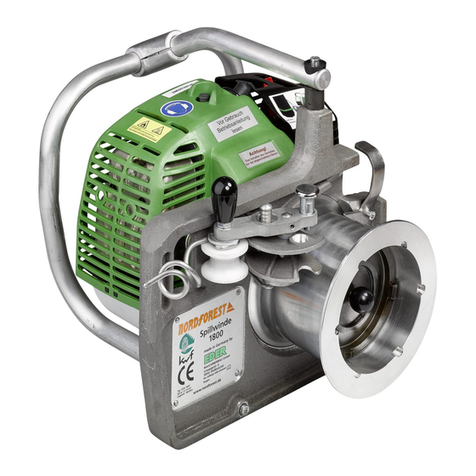
NORDFOREST
NORDFOREST 1800 operating manual

Mile Marker
Mile Marker MISSION Series Installation & operator's manual
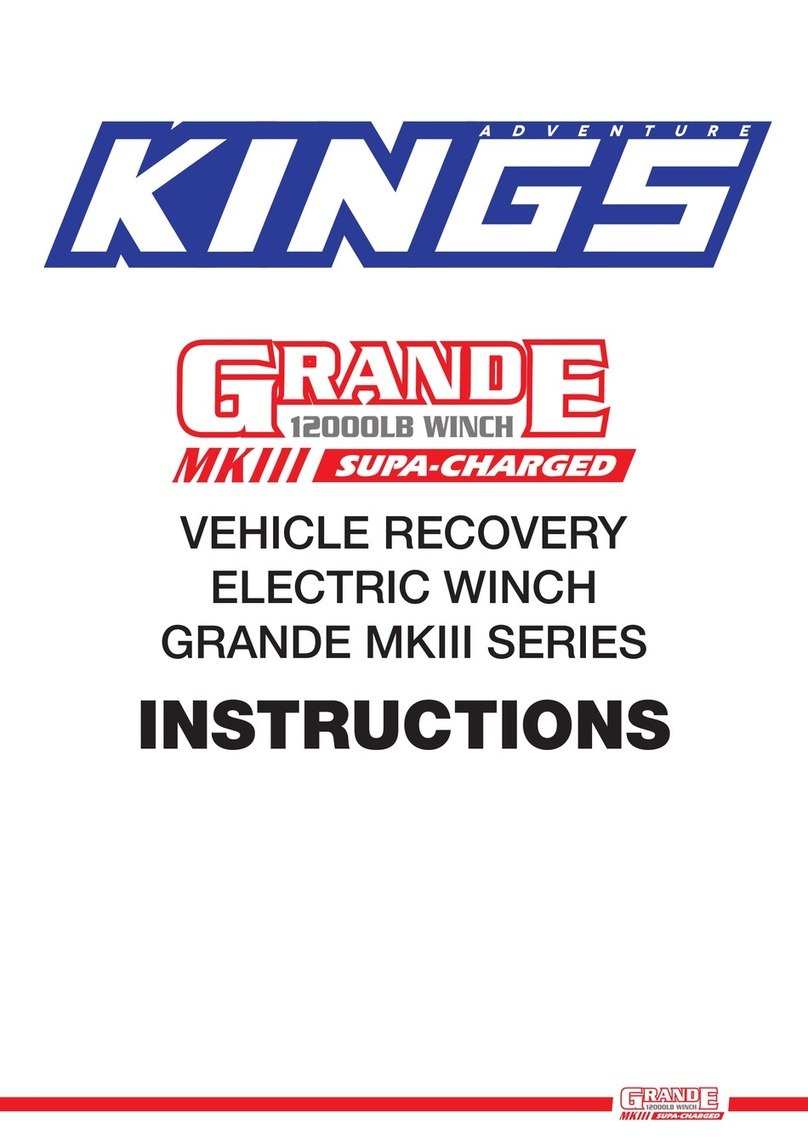
Kings Adventure
Kings Adventure Grande MKIII Series instructions
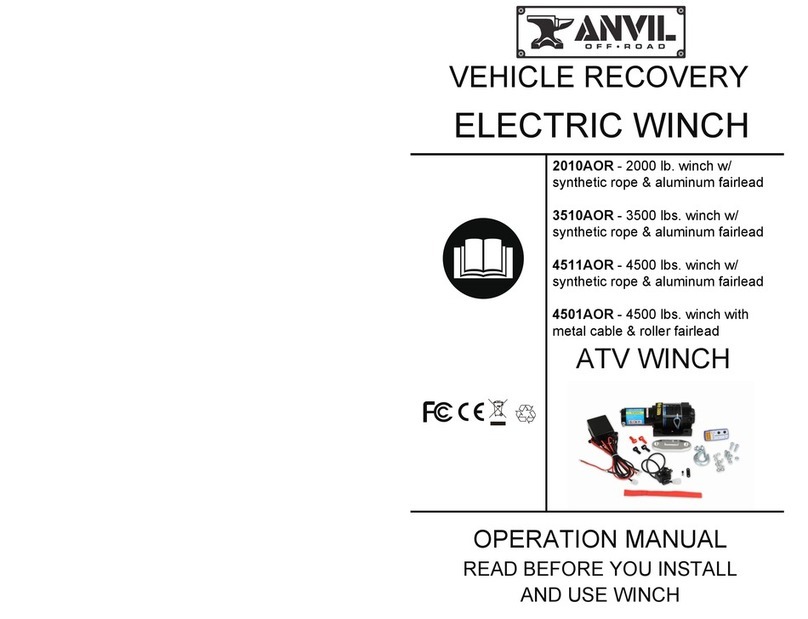
Anvil
Anvil 2010AOR Operation manual

Kolpin Outdoors
Kolpin Outdoors 25-2360 Assembly & owners manual

Ingersoll-Rand
Ingersoll-Rand Man Rider LS2-150RLP-L E Series Product Maintenance Information



